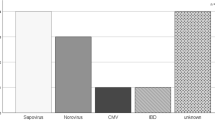Abstract
Human sapovirus (HuSaV) is a common cause of gastroenteritis worldwide and is responsible for approximately 4% of acute gastroenteritis episodes in Europe. As reported with norovirus, patients with immunocompromised states are at increased risk of developing HuSaV infection, which can lead to persistent diarrhea and chronic viral shedding in some individuals. Chronic infections are incompletely investigated in these patients, and, due to the lack of specific treatment for HuSaV infection, different clinical approaches were carried out in order to provide further evidence on clinical evolution of these patients with different treatments. In this retrospective study, we report five immunocompromised pediatric patients with recurrent diarrhea caused by HuSaV and long-term viral shedding. Stool samples were analyzed by real-time PCR and tested for enteropathogenic viruses and bacteria and protozoa. Among transplant recipients, reduction of immunosuppressant therapy led to clinical improvement and relief of symptoms, maintaining a balance between managing the infection and preventing graft rejection. Nitazoxanide for 14 days was only used in one of these patients, showing to be an effective therapy to achieve reduction in time to resolution of symptoms. Neither nitazoxanide nor modification of immunosuppressant therapy could avoid recurrences. Further investigations are needed to develop new approaches that can both clear the infection and avoid persistent diarrhea in these patients.
Similar content being viewed by others
Data availability
The authors guarantee the transparency of the data.
References
Svraka S, Vennema H, van der Veer B et al (2010) Epidemiology and genotype analysis of emerging sapovirus-associated infections across Europe. J Clin Microbiol 48(6):2191–2198. https://doi.org/10.1128/JCM.02427-09
Bennett S, Gunson RN (2017) The development of a multiplex real-time RT-PCR for the detection of adenovirus, astrovirus, rotavirus and sapovirus from stool samples. J Virolog Methods 242:30–34. https://doi.org/10.1016/j.jviromet.2016.12.016
Wright S, Kleven D, Kapoor R et al (2020) Recurring norovirus & sapovirus infection in a renal transplant patient. IDCases 20:e00776. https://doi.org/10.1016/j.idcr.2020.e00776
Neres Silva T, Dábilla N, Santos Corrêa T et al (2020) Sapovirus detection and quantification in fecal samples from allogeneic hematopoietic stem cell transplant recipients. VirusDis 31(3):374–377. https://doi.org/10.1007/s13337-020-00583-1
Roos-Weil D, Ambert-Balay K, Lanternier F et al (2011) Impact of norovirus/sapovirus-related diarrhea in renal transplant recipients hospitalized for diarrhea. Transplant 92(1):61–69. https://doi.org/10.1097/TP.0b013e31821c9392
Krones E, Högenauer C (2012) Diarrhea in the immunocompromised patient. Gastroenterol Clin North Am 41(3):677–701. https://doi.org/10.1016/j.gtc.2012.06.009
Pietsch C, Liebert UG (2019) Intrahost viral evolution during chronic sapovirus infections. J Clin Virol 113:1–7. https://doi.org/10.1016/j.jcv.2019.02.001
Becker-Dreps S, González F, Bucardo F (2020) Sapovirus: an emerging cause of childhood diarrhea. Curr Opin Infect Diseas 33(5):388–397. https://doi.org/10.1097/QCO.0000000000000671
Ghusson N, Vasquez G (2018) Successfully treated norovirus- and sapovirus-associated diarrhea in three renal transplant patients. Case Rep Infect Diseas 2018:1–4. https://doi.org/10.1155/2018/6846873
Rossignol JF, El-Gohary YM (2006) Nitazoxanide in the treatment of viral gastroenteritis: a randomized double-blind placebo-controlled clinical trial. Aliment Pharmacol Ther 24(10):1423–1430. https://doi.org/10.1111/j.1365-2036.2006.03128.x
Haubrich K, Gantt S, Blydt-Hansen T (2018) Successful treatment of chronic norovirus gastroenteritis with nitazoxanide in a pediatric kidney transplant recipient. Pediatr Transplant 22(4):e13186. https://doi.org/10.1111/petr.13186
Thiagarajah JR, Martin MG (2022) Approach to chronic diarrhea in neonates and young infants (<6 months). UpToDate Web https://www-uptodate-com.m-hulp.a17.csinet.es/contents/approach-to-chronic-diarrhea-in-neonates-and-young-infants-less-than6 months?search=approach%20to%20chronic%20diarrhea%20in%20neonates&source=search_result&selectedTitle=1~150&usage_type=default&display_rank=1. Accessed 10 June 2023.
Lozano NA, Lozano A, Marini V et al (2018) Expression of FcRn receptor in placental tissue and its relationship with IgG levels in term and preterm newborns. Am J Reprod Immunol 80(3):e12972. https://doi.org/10.1111/aji.12972
Boniel S, Szymańska K, Śmigiel R et al (2021) Kabuki syndrome—clinical review with molecular aspects. Genes 12(4):468. https://doi.org/10.3390/genes12040468
Lindsley AW, Saal HM, Burrow TA et al (2016) Defects of B-cell terminal differentiation in patients with type-1 Kabuki syndrome. J Aller Clin Immunol 137(1):179–187.e10. https://doi.org/10.1016/j.jaci.2015.06.002
Adam MP, Hudgins L, Hannibal M (2022) Kabuki syndrome GeneReviews Web. https://www.ncbi.nlm.nih.gov/books/NBK62111/. Accessed 12 May 2023.
Boillat Blanco N, Kuonen R, Bellini C et al (2011) Chronic norovirus gastroenteritis in a double hematopoietic stem cell and lung transplant recipient. Transpl Infect Dis 13(2):213–215. https://doi.org/10.1111/j.1399-3062.2010.00565.x
Engelen MA, Gunia S, Stypmann J (2011) Elimination of norovirus in a chronic carrier under immunosuppression after heart transplantation--effect of everolimus. Transpl Int 24(11):e102–e103. https://doi.org/10.1111/j.1432-2277.2011.01330.x
Rossignol JF (2014) Nitazoxanide: a first-in-class broad-spectrum antiviral agent. Antiviral Res 110:94–103. https://doi.org/10.1016/j.antiviral.2014.07.014
Hedvat J, Salerno DM, Kovac D et al (2022) Nitazoxanide treatment for norovirus infection in solid organ transplant recipients. Clin Transplant 36(3):e14594. https://doi.org/10.1111/ctr.14594
Kempf B, Edgar JD, Mc Caughey C et al (2017) Nitazoxanide is an ineffective treatment of chronic norovirus in patients with X-linked agammaglobulinemia and may yield false-negative polymerase chain reaction findings in stool specimens. J Infect Dis 215(3):486–487. https://doi.org/10.1093/infdis/jiw497
Davis A, Cortez V, Grodzki M et al (2020) Infectious norovirus is chronically shed by immunocompromised pediatric hosts. Viruses 12(6)):619. https://doi.org/10.3390/v12060619
Daniel-Wayman S, Fahle G, Palmore T et al (2018) Norovirus, astrovirus, and sapovirus among immunocompromised patients at a tertiary care research hospital. Diagn Microbiol Infect Dis 92:143–146. https://doi.org/10.1016/j.diagmicrobio.2018.05.017
Code availability (software application or custom code)
Not applicable.
Author information
Authors and Affiliations
Contributions
All authors contributed to the study conception and design. Material preparation, data collection, and analysis were performed by all authors. All authors read and approved the final manuscript.
Corresponding author
Ethics declarations
Ethics approval
Not applicable.
Consent to participate
Not applicable.
Consent for publication
Not applicable.
Competing interests
The authors declare no competing interests.
Additional information
Publisher’s note
Springer Nature remains neutral with regard to jurisdictional claims in published maps and institutional affiliations.
Rights and permissions
Springer Nature or its licensor (e.g. a society or other partner) holds exclusive rights to this article under a publishing agreement with the author(s) or other rightsholder(s); author self-archiving of the accepted manuscript version of this article is solely governed by the terms of such publishing agreement and applicable law.
About this article
Cite this article
Rubio-Mora, E., Carrascoso, G.R. & Rodríguez, J.G. Sapovirus infection as another cause of persistent viral diarrhea: case series and review of the literature. Eur J Clin Microbiol Infect Dis 43, 55–59 (2024). https://doi.org/10.1007/s10096-023-04695-6
Received:
Accepted:
Published:
Issue Date:
DOI: https://doi.org/10.1007/s10096-023-04695-6




